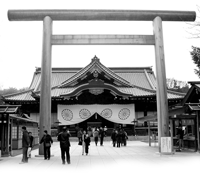Yasukuni Shrine
Why is the Yasukuni shrine controversial? – By Lee Ji-yoon (Korean)
 The Yasukuni shrine is a place that is dedicated to the spirits of soldiers who died for Japan in its wars. The former Japanese Prime minister, Koizumi Junichiro, went to this shrine six times every year while he was in office from 2001 to 2006. His visits to the shrine were very controversial in many of the Asian countries that were invaded by Japan. Those Asian countries were concerned that Koizumi? visits to the shrine were a sign of Japan? willingness to repeat its militaristic imperialism. However, Koizumi consistently insisted that his visits were only for honoring Japan’s war dead. Despite the controversy over the political implication of his visits to the shrine, he stuck to his position.
The Yasukuni shrine is a place that is dedicated to the spirits of soldiers who died for Japan in its wars. The former Japanese Prime minister, Koizumi Junichiro, went to this shrine six times every year while he was in office from 2001 to 2006. His visits to the shrine were very controversial in many of the Asian countries that were invaded by Japan. Those Asian countries were concerned that Koizumi? visits to the shrine were a sign of Japan? willingness to repeat its militaristic imperialism. However, Koizumi consistently insisted that his visits were only for honoring Japan’s war dead. Despite the controversy over the political implication of his visits to the shrine, he stuck to his position.
The primary issue of this controversy is that his visiting the shrine reflects Japan’s lack of will to repent for its war history. The shrine possesses a list of war dead deified as gods. The list includes fourteen Class A war criminals, who were actively involved in World War II. Tojo Hideki, the Japanese Prime Minister during WWII, was enshrined there after the war ended. He was the person who led Japanese soldiers and brought Asians to battlefields. Korea, China and many other Asian countries experienced tremendous damage and suffered from the war. For them, Japanese politicians?honoring the war criminals is hardly acceptable.
Someone may say that paying respect to people who died for their country is basic human compassion. Here, it should be reminded that few Asian countries raise issues of ordinary Japanese people visiting the shrine. The primary issue is about the Japanese Prime Minister visiting the shrine. Prime minister is a position that influences people in various and even unexpected ways. For instance, his visiting the shrine could encourage extreme right-wing groups such as the Japanese Society for History Textbook Reform to glorify the militaristic history of Japan. It does not matter whether Koizumi intended to cause such consequences.
Asians are deeply concerned with the revival of militarism in today? Japan. I hope that conscientious Japanese people will remember that WWII was a tragic history not only of other Asians but also of the Japanese. Even Japanese teenagers were forced to go to the war. At the end of the war, atomic bombs took innocent lives in Hiroshima and Nagasaki. Whether a country is wining or losing, a war deprives the basic human right to live. It is the Japanese people who can stop the dangerous trend of militarism that is emerging from the Japanese government. The Yasukuni shrine provides a great chance to learn how to resolve conflict and build peace in Asia.
Go beyond the Yasukuni shrine – By Choi Jee-seun (Korean)
 The former Japanese Prime Minister, Junichiro Koizumi, visited the Yasukuni shrine every year during his five-year term in office. Japanese assemblymen followed in his track and visited the shrine. These visits of high-profile Japanese politicians to the shrine disregard the feelings of people in the Asian countries that were devastated by Japanese military intervention. Yasukuni enshrines fourteen Class A war criminals who were responsible for atrocities in Asian countries, such as China and Korea, during World War II. The governments of the countries who were most affected by the Japanese military criminals have opposed visits to the shrine by Japanese political leaders. However, disregarding the concerns of other Asian governments, Japanese politicians kept visiting the shrine without showing repentance for what was done in the past. Their visits to the shrine are hard to justify.
The former Japanese Prime Minister, Junichiro Koizumi, visited the Yasukuni shrine every year during his five-year term in office. Japanese assemblymen followed in his track and visited the shrine. These visits of high-profile Japanese politicians to the shrine disregard the feelings of people in the Asian countries that were devastated by Japanese military intervention. Yasukuni enshrines fourteen Class A war criminals who were responsible for atrocities in Asian countries, such as China and Korea, during World War II. The governments of the countries who were most affected by the Japanese military criminals have opposed visits to the shrine by Japanese political leaders. However, disregarding the concerns of other Asian governments, Japanese politicians kept visiting the shrine without showing repentance for what was done in the past. Their visits to the shrine are hard to justify.
In an interview after visiting to the shrine, Koizumi said that he could not understand why other countries were interfering in Japan? domestic affairs, and his visit was to commemorate the sinless Japanese soldiers, not the military criminals who invaded other Asian countries. Nevertheless, it is clear that the shrine also worships the war criminals. Kim Hyunki, a Tokyo correspondent of a Korean newspaper, points out in his editorial that if someone goes to church, people probably think that this person believes in God (JoongAng Daily, August 16, 2006)*. This also applies to Koizumi’s visiting to the shrine. That he visited the shrine to honor only the sinless solider is not an acceptable excuse.
High-profile politicians’ visits to the shrine cannot be personal, but political. They try to evade responsibility by personalizing their acts. However, they are politicians, and the Prime Minister of Japan is a person who represents Japan. Their visits to the shrine are political acts. The Japanese government has been accused of glorifying its history of militaristic imperialism by other Asian countries. In such a situation, Japanese politicians?visiting Yasukuni shrine further deteriorates the relationship between Japan and other Asian countries.
Japanese politicians should stop visiting the Yasukuni shrine and show that they are facing their history in a responsible manner. Some may say that they were not involved in the war crimes, and new generations should let go of the past and make a new start. However, they need to remember that they live in a country that was made by their ancestors, whether they get advantages or disadvantages from what their ancestors did. By stopping their visits to the Yasukuni shrine, Japanese politicians will show its will to take responsibility for its history and to keep peace in Asia. I hope that peace-loving Japanese people will ask their politicians, in the name of peace, to not visit the Yasukuni shrine. Then, Asian countries can forgive Japan, and move toward a peaceful Asia.
* Reference : Kim Hyunki (August 16, 2006). An open letter to Jinichiro Koizumi, JoongAng Daily





 Copyright @ 1999-2012 VANK. All rights reserved.
Copyright @ 1999-2012 VANK. All rights reserved.
You must be logged in to post a comment Login